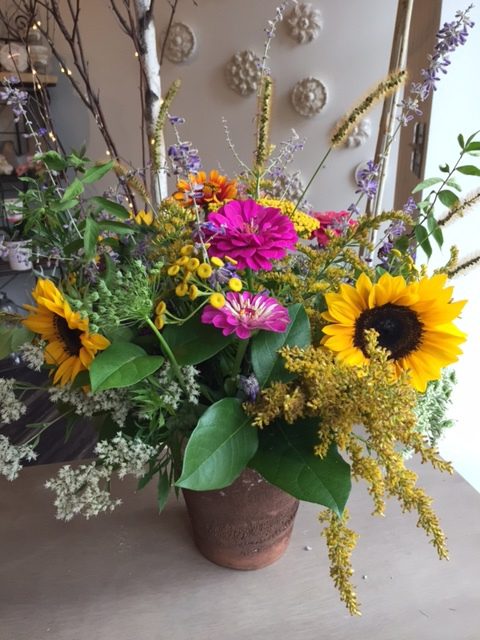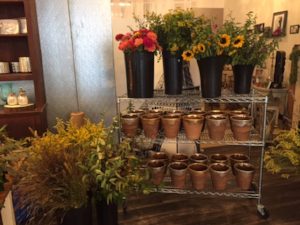Arranging Flowers in Water: Tips, Techniques and Videos
Oct, 4, 2016
Last week, Jennifer taught her September floral arranging classes at our studio in Leesburg, Virginia. The team at J. Morris had selected a design that featured a hip, fall wildflower arrangement in an earthenware pot and flowers grown right here in Loudoun County. The evening began with introductions and a sampling of two wines suggested by Stone Tower Winery – perfect pairings for this earthy bouquet.
Jennifer began her instruction by demonstrating the “French Weave.” When working with water, designer’s weave the greenery and flowers in the vase to create a structure where they will later be able to secure their focal stems. “A French Weave is an armature, a structure that supports flowers. There are many methods you can use to create stability for your flowers. Effective floral arranging involves using an armature of some sort, whether self-made like the weave, or from purchased product like tape or chicken wire.”

By Heather Lipp, J. Morris Flowers
Jennifer cut each of her stems to similar lengths and poked them in from the sides. She explained that no stem should ever be dropped straight down into the opening of a vase in the vain hope that it will stay in place. “We have all bought the bundles of flowers at grocery stores that look so beautiful in the wrapper. You get it home, treat the stems and then drop it in to the vase hoping that everything stays in that pre-arranged shape.”
Greenery is an important part of arranging in water for the security of the flowers and achieving that lovely designer shape. Grocery store bundles rarely supply enough greenery but greens are often sold separately. This extra supply should be part of your purchase.
It is so important to make a fresh cut right before you put a stem in to the water and cut the stems at an angle. Jennifer explains, “If you have a flat bottom, and your stem ends up on the bottom of the vase, there is no way for the flower to absorb water. An angled cut creates more stem surface for more water absorption.”
Watch this video to understand why a fresh-cut is so important:
Flowers in the arrangement

Vases painted in either silver or gold and long, local grown stems.
Jennifer described the flowers the participants would be using. Most of the flowers were provided by local grower Leah Foster from “Fleur de Leah” and included Sunflowers, Tansy, Queen Anne’s Lace, Rice Flower, Mexican Sage, Beauty Bush, Lemon Leaf and Zinnias. Jennifer made a special point about the Zinnias. “Look at these Zinnia’s. It’s really hard to get good quality Zinnias from commercial growers. That’s why we are so lucky to live in a place where growers can raise these types of flowers.”
This vase lent itself well to an armature made from chicken wire. The class mounded a small piece of wire into a dome and put it in the bottom of their vase. Then they added water –a key ingredient – before they cut a single stem. Jennifer made an important point about stem lengths. “The thing to keep in mind is that your stems need to go all the way to the bottom. A stem that is only long enough to reach a third to half way down will die as the water evaporates. Floral preservative — you get that packet when you purchase flowers. Put all of it in every time.”
The last step before beginning to add greenery and flowers is to imagine the shape.
Watch this video as Jennifer explains this important step in the planning process.
According to Jennifer, “You define your shape with the greenery right away. Wildflowers are nice to work with because nothing is too ‘drapey.’ If our goal is a nice, tall rounded shape, then these types of flowers will help us to achieve that.” After creating a nest with lemon leaf, members used stems with bigger blooms to create fillers.
Stripping leaves from each stem was a crucial step. “There should be no leaves below the water line. You can run your hand along the bottom of the stem to remove lower leaves. Clean water is so important and dying leaves can affect the life expectancy of your arrangement.”
Members of the class were curious about how to judge the length of the stems. “As you begin to trim your stems, keep in mind that it is best to cut the stem too long, rather than too short, especially as you learn to analyze each stem. This is a taller arrangement which is why we’ve asked Leah to cut the flowers close to the root” As each member filled in their arrangement, mindful of the shape they were trying to create, Jennifer provided some individual tip and ideas. The most colorful and textured blooms, the ones that catch your eye, were saved for the final steps in the arrangement.
Watch this video to learn more about filling and finishing
As Jennifer concluded the evening she made an important point about the design. “Our original inspiration for this design was an arrangement created by a floral designer in New York City but we have really made this beautiful and clearly Loudoun County.
Jennifer and her team would like to thank Stone Tower Winery who provided some suggested wine pairings for this arrangement, Leah Foster, who worked so hard to have blooms freshly cut from her farm in Hamilton, Va and of course, the members of the class who made it so much fun.
For information about our next class, please click this link.
We are happy to send you a notification each week about our most recent blog. Complete this form to subscribe.


Leave a Comment